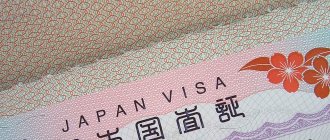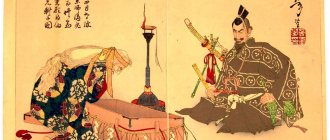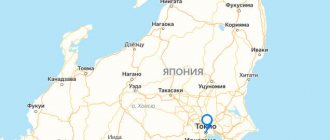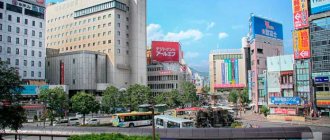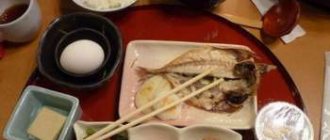Ryokan - a temple of Japanese hospitality
In addition to Western-style hotels, there are ryokans in Japan - hotels in which everything is furnished in the spirit of traditional Japanese culture.
Everything here is subject to seasonality; The interiors of the washitsu rooms are made in the Japanese style with all its essential elements: tatami mats, movable shoji partitions, a tokonoma niche in which a kakemono wall scroll hangs and ikebana (flower arrangement) is displayed. People sleep in such rooms not on beds, but on traditional sleeping mattresses - futons. At the ryokan you can take a Japanese o-furo bath and immerse yourself in the tranquil atmosphere of a Japanese traditional home. Such famous actors as Tommy Lee Jones and Tom Cruise have openly admitted their love for Japanese ryokans.
Typically, a ryokan has at least five guest rooms, but there can be many more. Some establishments have more than eighty rooms for guests. According to 2014 statistics, there are about forty-three thousand ryokans throughout Japan, the menus of which, as well as the rules for serving guests, vary depending on the region. The hotel manager and okami hostess (who designs the rooms and the building, as well as the ceremonial side of the service) go to great lengths to ensure that their establishment is unlike any other, so you're unlikely to find two identical ryokan.
Western style hotels in Japan
Western-style hotels are available in all Japanese cities , and in the main cities of the country, hotels of famous international hotel chains are widely represented. The staff at these hotels speak English. At the height of the tourist season, it is better to take care of booking a hotel in advance.
Most Western-style hotels provide the same range of services as other hotels anywhere in the world, including heating, television, air conditioning, swimming pool, shopping and health centers. An additional service of providing an interpreter is possible.
The estimated cost of a room with all amenities in first-class hotels in Tokyo ranges from 15,000 to 30,000 yen for a single room, and from 25,000 to 63,000 yen for a double room.
Ryokan: the ABC of a guest
The ryokan has a special employee, nakai, who is both a personal servant and your advisor on all everyday matters during your stay in the ryokan. She will tell you about the customs of the ryokan, will take care of your comfort and convenience with truly Japanese hospitality, and will lay out your futon at night and remove it in the morning.
Just as is customary in Japanese homes, it is customary to take off your shoes and put on slippers when entering a ryokan. If guests need to go outside for a short time, they can use sandals or traditional geta shoes, which can be borrowed from the ryokan.
Unlike hotels, the ryokan does not have a fitness room or swimming pool. Most often, in addition to a separate private bathroom, visitors can also use public baths (separate for men and women) and rotemburo - outdoor baths. Some ryokan have karaoke and table tennis rooms for guests.
Rothemburo
After a leisurely swim in the o-furo, the guest changes into a comfortable yukata robe prepared in advance for him, which does not restrict movement, which is also used as pajamas. After changing clothes, it is not at all necessary to stay in the room, because in a ryokan, yukata is a common form of clothing for all vacationers. And if the ryokan is located in some town with thermal springs, then in the hotel yukata you can safely walk along the street.
Guests often spend one night at the ryokan, receiving two meals a day. You can have dinner either in the dining room or in your room. If a guest has ordered dinner to the room, the nakai servant brings the order to him and makes sure that everything is served on the table in a timely manner. She also takes orders for alcoholic drinks. A special pleasure is to order dishes made from seasonal and locally produced products.
Dinner served in the room. In the background is a tokonoma niche with a kakemono wall scroll and a flower arrangement (ikebana).
As a rule, in modern Japan, guests do not pay tips in either hotels or ryokans, but in some places the custom of leaving a monetary gift (tip) to the nakai is still preserved as a sign of gratitude. Unlike hotels, it is almost impossible to get into a ryokan for an overnight stay without making a reservation in advance, so it is important to make a reservation online or by phone in advance.
Ryokan Kurashiki
The ryokan is located in Bikan, the historical part of Kurashiki City. It was opened in 1957. Previously, this ryokan had only 5 rooms, but this year they added 3 more. The new rooms have a view of the canal and also receive a lot of natural sunlight, so they are more popular. However, if you want to stay where Sophia Loren once stayed, then choose one of the original rooms, in particular the Okuzashiki Suite.
After you've explored the Bikan area, be sure to rest and relax at the onsen, which can be booked free of charge for private one-hour sessions. And after that you can go for a gourmet dinner at Kaiseki. Here you will be served a bowl of rice with aromatic broth and yellow leeks. And in the morning, for breakfast in the dining room overlooking the quiet garden, you will be served grilled butterfly fish.
Feel the harmony in everything: in architecture, dishes, furniture
Visiting a ryokan is an excellent opportunity to get to know Japanese architecture better, as well as a chance to use antique dishes and household utensils, as some establishments are already a hundred or even two hundred years old. And such places are not uncommon.
The Keiunkan ryokan in Yamanashi Prefecture was founded in 705. This hotel is listed in the Guinness Book of Records as the oldest hotel currently operating in the world. The Hoshi ryokan (link in English and Japanese) in Ishikawa Prefecture has a slightly shorter history - it was founded three years later, in 718. Three of the most renowned ryokans in Kyoto for their fine cuisine: the nearing 300-year-old Tawaraya, where Steve Jobs always stayed; famous for the high quality of the tea ceremony and kaiseki cuisine "Sumiya" and the favorite place to stay for members of the imperial family and famous writers "Hiiragiya".
Ryokan (hotel)
A ryokan is a traditional Japanese style hotel. For foreign tourists, the ryokan is one of the main attractions in Japan. Kyoto is considered the city with the largest number of ryokans.
Society Culture Customs Customs and etiquette in Japan
1.1. general description
Exterior
The ryokan is a small hotel with a specific shape, with a characteristic curved roof.
Newer buildings have a modern Western look. Inside, on the ground floor, there is a hall where tourists can relax and talk, and also watch TV if available. The hotel is decorated in a traditional Japanese style - you can see wall paintings with kana or hieroglyphs, characteristic drawings, as well as ikebana decorating the interior. 1.2. general description
Rooms
Guest rooms also have a traditional look - the floor is lined with tatami straw mats, and the balcony doors are shoji bamboo grates covered with thin paper.
The door leading into the room can also be shoji, but recently, for security purposes, interior doors made of more durable materials have been used. In each room there is a small table with tea accessories, at which guests can dine, as many prefer to eat in their rooms. 1.3. general description
Features
In ryokans, it is customary to sleep on futons laid on tatami rather than on beds.
Sometimes this causes some inconvenience for older people, so modern hotels with all amenities are more suitable for people in this category. In addition, the rooms do not have a bathroom - guests use a shared bathhouse - ofuro. There are separate entrances to the bathhouse for men and women. For example, women use the bathhouse on the first day, and men the next day. Thus, there is an alternation. Some modernized ryokans have rooms with private bathrooms, but this is generally rare and costs much more. 2. Staff
The ryokan staff is predominantly women, dressed in kimonos. The attitude of ryokan employees towards visitors is somewhat different than in modern hotels, since all services are provided only upon request of the client, and in general the level of service is considered to be very high. As soon as tourists arrive at the hotel, they are immediately shown to their room, and the maid brings some local food and green tea. The Japanese, as well as in other countries, have a custom of giving tips to servants, but with a slight difference: here they are given only once, and must be wrapped in an envelope.
3. Prices
Many ryokans that are not located in tourist centers will cost tourists quite inexpensively. For a night spent in such a hotel, you can pay about 40 dollars. But most ryokans, especially in Kyoto, are located in beautiful scenic locations, and for one night in these hotels you will have to pay much more, about four hundred dollars. Expensive ryokans are often surrounded by famous Japanese gardens, many are located on the sea coast, and some are located in mountainous areas. The beautiful nature around the hotel plays an important role when choosing a ryokan and greatly influences the price.
4. Food
As for food in the ryokan, the cuisine here is also traditional, it is called “kaiseki”. Meals are usually served twice a day and are included in the room price. The dishes served in the ryokan are small in size, but nevertheless the quantity is quite large. Most of the dishes are made from a variety of seafood - fish, squid, shrimp, etc. For example, hotel visitors may be offered to try raw fish sashimi, and in addition to seafood, freshly picked wild vegetables. Eating food is done with chopsticks called hashi.
5. Options
In addition to full-fledged ryokans, there is also a budget version of a Japanese hotel called minshuku 民宿. While a ryokan is a full-fledged hotel focused exclusively on welcoming guests and offering high-class service, for many minshuku, hosting guests is not the main specialty - often it is just a few rooms in a traditional Japanese house, rented out by the owners for overnight stays for passing travelers. This type of inn is most common in rural areas of Japan, especially in villages too small to support a full-fledged inn or ryokan. In general, the service in minshuku is close to that in a ryokan, but is more informal, and the services are often more spartan: for example, most rooms in minshuku do not have a separate toilet, and instead of onsen, which is almost mandatory in ryokans, guests are provided with a regular bathroom. Also, minshuku usually does not serve lunch and dinner, but only breakfast, and the cuisine in general is much simpler. Due to this, prices in such hotels are much lower and, as a rule, do not exceed half the cost of a stay in a “real” ryokan.
6. Etiquette
You can only walk on the tatami covering the floor in the room barefoot. Many ryokans lock the door at 11 pm. Each room of the ryokan must have a tokonoma, in which an ikebana can be placed, and a kakejiku - a scroll with a picture, calligraphy, etc. You cannot enter the front of the hotel until the owner appears. In high-end ryokans, guests are required to strictly adhere to local etiquette. In a ryokan, you can wear a special kimono called a yukata, which is located in each guest's room. You can wear a kimono both in the hotel and outside it.
7. Examples of ryokans
The Kanaya Hotel in Nikko and the Fujiya Hotel in Hakone Township are also the oldest hotels. The Tawariya, Sumiya and Hiiragiya hotels in Kyoto are considered top-class hotels. The Hoshi Hotel in Komatsu has been continuously owned by the same family since 717.
This is a ryokan, a ryokan of Kyoto, a ryokan of a poet
- Ryokan Ryokan is a traditional Japanese style hotel. Ninsho Ryokan 忍性良観, 1217 - 1303 - head of the Japanese Buddhist school of Risshu in Japan during the Kamakura period
- Hoshi - Ryokan Japanese. 法師旅館 is a ryokan in Komatsu City, Ishikawa Prefecture, Japan. Founded in 717, it was considered the oldest existing hotel in the world until
- business and goes to Krolmeister’s favorite hotel - the Hiei Ryokan in Japan. But upon arrival, she discovers that things are not going smoothly at the hotel - periodically
- deceased. In 1952, she converted the Tomiya Shokudo into a Japanese-style ryokan hotel so that relatives of fallen pilots could stay there.
- arrive: the owner of the ryokan, her assistant and the pharmacist. All of them find themselves hostage to spirits. The girl sees the past in which the ryokan used to be public
- architect E. G. Rekalo The two-story building is located on the red line of Bolshaya Sadovaya Street between the Kostanaev apartment building and the Moskovskaya Hotel
- covering the genitals with a towel. Guests of traditional Japanese ryokan hotels will be offered to use a shared ofuro or individually if it was
- Afinogenova - Leonid Borisovich 1948 - For those who are at sea B. A. Lavreneva - Rekalo 1948 - Dog in the manger L. de Vega - Tristan 1948 - Taimyr is calling you
- For those at sea B. A. Lavreneva, director D. V. Tunkel - officer Rekalo 1947 - First thunder M. I. Aliger, directors A. D. Popov and M. O. Knebel
- concentrated in the area: 120 Guards. SD Schmertzke 2 km south of Brandenburg claim. Ryokan Goltsov, Michelsdorf, claim. Ezerig 269 SD claim. Kirhaleser 9 km southwest
- Futons laid out for sleeping at a Ryokan hotel
- collection M.: Natalis Ripol - classic. 2004. 479 p. Japanese traditional ryokan inns in the country's culture. M.: Knigodel, 2007. 148 p. Kuznetsov, Alexey Petrovich
Ryokan hotel:
Ryokan Kyoto, ryokan this, ryokan poet
Traditional hotels in Japan: sukubo, hatago, ryokan.
Ryokan is a traditional Japanese inn. While in Japan, try something you won't find in any other country: stay in a ryokan. Japanese traditional ryokan hotel Japanese First. Japanese ryokans. Probably everyone has already heard that a ryokan is a traditional Japanese inn, a kind of combination of personal and social life, like.
Ryokan Houshi Onsen: an ancient hot spring hotel in.
Review: Ryokan Kyoraku Hotel Japan, Kyoto You can't break the shoe code here, but you can break the dress code! 01/22/2018. Review recommended: 222. Ryokan hotel in Japan where people sleep on the floor – Vinsky’s website. Card Ryokan traditional Japanese hotel from the collection Hotels in Japan in ections. Ryokan traditional Japanese hotel card of the user. A Japanese ryokan is a traditional Japanese style hotel with the atmosphere of feudal Japan. The ryokan is called the temple of Japanese hospitality.
What is a traditional Japanese ryokan? Hoshi Ryokan.
Ryokan: a truly Japanese hotel. Ryokan ryokan, 旅館, ryokan is a traditional Japanese inn from the Edo period 1603–1868. Ryokan hotel in old Japanese style. Peekaboo. Hotels in Tokyo and Kyoto. List of the best hotels. Kyoto Garden Ryokan Yachiyo is surrounded by beautiful Japanese gardens. Ryokan hotel in traditional Japanese style. Floors. Ryokan Nishiyama Onsen Keiunkan has been welcoming guests to the Hayakawa spa resort in Yamanashi Prefecture for over 1,300 years! All this time a guest house.
Review of Ryokan Kyoraku Hotel Japan, Kyoto Shoes.
“Ryokan” is a traditional Japanese hotel, translated from Japanese as “a home for a traveler.” Anyone who wants to feel it. Ikano Onsen Aoyama Ryokan, hotel, Japan, Minakami, 377. In other ryokans they will give you everything and pour it right at the reception while the owner talks about the hotel and the city. Thirdly, you are right in.
Tour to Japan Japanese hot springs and thermal resort.
Ryokan Japan. A ryokan is a traditional Japanese inn. This is exactly what houses looked like in the Land of the Rising Sun. Ryokan hotel is What is a Ryokan hotel? Usually, upon arrival at the ryokan, you need to change into a yukata robe and then move around the entire hotel in it. Many ryokans are located on.
Ryokan Hotel Japan Magic Tour.
Ryokans. Traditional Japanese Ryokan Hotel For a complete immersion in the Japanese lifestyle, ryokan hotels are the perfect choice. Hoshi Ryokan is the oldest and most terrible hotel in. Inn Matsubaya Matsubaya, a classic ryokan, has been welcoming guests to Kyoto for a century and a quarter. The hotel is well located. Ryokan. Hotel in traditional Japanese style PHOTO NEWS. Ryokan hotel in traditional Japanese style. For foreign tourists, this is one of the attractions of Japan. Ryokan and Onsen Flight Tourist. A ryokan is a traditional Japanese style hotel. The word ryokan 旅館 is translated as hotel. I had a chance in Kyoto. Hoshi Ryokan is an inn that has been owned by 46 generations. Kuzhel Yu.L. With all the variety of accommodation options, national ryokan hotels occupy a special place in the life of the Japanese.
How to live in a traditional ryokan hotel The same Wren.
To do this, just cross the threshold of a Japanese hotel ryokan. Because the ryokan for its purpose is an improved one. Ryokans in Japan ☺️ Useful post about Japanese ryokans. A ryokan is a traditional inn, differing in many ways from the standard Western-style hotels that abound in Tokyo and elsewhere.
Ryokan: a truly Japanese hotel Traditions Articles about.
The oldest Japanese inn, the Hoshi Ryokan, which is located at the Awazu hot springs in Ishikawa Prefecture, is 1,300 years old. This hotel. Hotel Hanagokoro Yamadeya Ryokan Annex Hanagokoro. Boutique hotel, ryokan or cave? A difficult test about the history of hotels., September 12, 2021. In the world, according to various estimates, from 200,000 to. Japanese Ryokans and Onsens AIC Information Center. A ryokan is a traditional Japanese style inn. The floors of the rooms are covered with straw tatami mats, on which it is customary to walk without shoes.
Kuzhel Yu.L. Subject environment of traditional Japanese hotels.
Description of the Ryokan hotel in Japan ✈ Tour operator Magic Tour ✈ at the lowest prices ✈ Departures from different cities of Russia ✈ We provide. Ryokan traditional Japanese hotel Club Hotel Club. Further information may vary slightly from hotel to hotel. What is a ryokan? Many people associate ryokans with. Tawaraya Ryokan 5 Tawaraya Ryokan, Kyoto, Japan rating. With accommodation in a traditional Japanese ryokan hotel on a thermal spring when the source is brought directly to the guest’s room in the ryokan hotel with. Where to live in Japan. Hotel in Tokyo, ryokan in Kyoto Vacations with. RYOKAN 旅館. If you want to experience the atmosphere of feudal Japan, you should definitely spend the night in a traditional Japanese ryokan.
Hotel Hiiragiya ryokan 4, book at the best price.
Ryokan Houshi Onsen, a traditional Japanese hot spring hotel, has been providing travelers with a pleasant stay for many years. Japanese Ryokan Guide in Tokyo Guide in Japan. Ryokan. Japanese traditional hotel. To experience the atmosphere of feudal Japan, you need to spend a night in a ryokan. 36 vacation rentals and apartments available in. There is a different gradation: there are standard hotels, the most inexpensive ones, hotels in the national style - ryokans, business hotels, class hotels. Hotels in Japan Japanese album. A traditional Japanese ryokan inn near the Yoshimatsu hot spring, built in the classic Sukiyazukuri style. This is a hotel with. Ryokan hotel in Japanese style Varvarka Travel. Brief description: A traditional Japanese ryokan hotel near the Yoshimatsu hot spring, built in the classic Sukiyazukuri style.
Japanese ryokans: why you need to look out the window.
A new hotel is always wonderful, especially if it is a ryokan, and even located in a modern high-rise building in itself. Ryokan hotel in Japanese style. Nearby is the more modern Annex Katsutaro Ryokan, which looks more like a hotel than a traditional Japanese hotel. MORE KATSUTARO. Traditional hotels 旅館 Martial arts school in Moscow. A ryokan is a small hotel with a specific shape, with a characteristically curved roof. Newer buildings have modern. The oldest hotel on earth is 1300 years old News. Ryokan traditional Japanese hotel Photos from Japan. la es.l. I have never visited Japan without staying in their ryokans.
Ryokan Yoshimatsu 4 Hakone Japan reviews, descriptions, photos.
Everything in this hotel is 100% Japanese: the interior, the architecture, the design of the rooms, the kitchen, and the procedure for serving guests. You will have it. The oldest hotel in the world Hoshi Ryokan, Japan The world is beautiful!. As soon as tourists arrive at the hotel, they are immediately shown their room. The ryokan hotel also helps most foreign tourists. Text of the film Harmony Shelter: Tawaraya Ryokan in Kyoto. Ikano Onsen Aoyama Ryokan ⭐, Japan, Minakami, 377 0102, Shibukawa, Ikaho machi Ikaho 11: photos, address and ️ phone number, opening hours, photos. Ryokan traditional Japanese hotel Tours to Japan. Ryokan hotel in traditional Japanese style. The floors of the rooms are covered with straw tatami mats, on which people walk only without shoes.
Transformation from ryokan to RYOKAN – consistently high quality when changing concept
Hot Springs in Winter - Ginzan Onsen, Yamagata Prefecture
Recently, the number of foreign tourists has increased, and ryokans have adopted a new format - overnight stays with one meal (bed and breakfast). Some hotels provide guests with handwritten maps with information about nearby stores where you can buy food and essentials, such as the popular Tokyo ryokan Sawanoya (link in English).
According to a survey of foreigners who visited Japan, among those who spent the night in a ryokan for the first time, the most common reason for spending the night in a ryokan was an interest in Japanese architecture and interior design in the washitsu style (63.8%). Among those who stayed in a ryokan five or more times, the reason was the desire to take a dip in an onsen hot spring (78.2%). Other features of a ryokan that are attractive to foreigners are “harmoniously arranged space” (65.8%), “calm, carefree relaxation” (60.3%), “Japanese cuisine” (59%). It turned out that the problem with language can be solved with the help of gestures, pictures, dictionaries and individual words. There is a special community that helps support foreign ryokan guests, it is called the Japanese Inn Group. There are other similar groups.
At the same time, in order to preserve the original Japanese cultural characteristics, ryokans are looking for ways to adapt to the diversity of the modern world. Ryokans are a good way to get to know Japan better and feel it. Next time, be sure to try staying in a ryokan for a worry-free getaway and enjoy true Japanese hospitality.
Recommended links (in English):
Yado net Japanese Guest Houses Japan Hotel & Ryokan Search
Banner photo: Ishikawa Prefecture, Wakura Onsen, Kagaya Ryokan. Nakai servants waiting for guests to leave
Japan hotels
There are 2 types of hotels in Japan. The one we are used to is a traditional (Western) style hotel, and our local type of hotel is the ryokan (described below). Rooms in traditional hotels are quite functional. When booking, everything is as usual - read the hotel description carefully, choose the accommodation conditions and amenities you need. Choose a large hotel chain, and you won’t get “unpleasant surprises.” Good reviews of hotels from the Tokyo Inn, Prince Hotel chains, and the cheaper Welcome Inn.
What should you do if, for some reason, you are forced to look for a hotel to stay locally while you are already in Japan? And if you don’t have access to the Internet to quickly select and book a hotel? The easiest way is to go to the nearest train station, where there is always a list of inexpensive business hotels and a travel information office that will book a room and give you the necessary telephone numbers.
Japan has also made its own unique contribution to hotel service - there are “ capsule hotels ”. They are usually located near central stations; they are a 1x2m plastic capsule, inside which is a sunbed, a towel, an alarm clock, and a TV. You cannot stay in them during the day, but you can leave your things. Registration is usually from 16.00 to 17.00 and often involves purchasing a ticket from the machine located in the lobby. But it is clear that this type of Japanese hotel is not suitable for family travelers; it is of interest only to active single tourists.
Where to live in Tokyo, Kyoto or other cities in Japan
The answer is clear - in any city it is better to live near the main railway station (railway station). Since in this case it will be more convenient for you to check into a hotel, go to the suburbs (where many attractions are located), and travel around the city (bus routes often run right from the stations). This applies to Kyoto, and to any other city in Japan.
As for Tokyo, the advice here is almost the same, but with a clarification - choose any large railway junction station. The city also has a well-developed network of electric trains, and they can largely replace the subway (especially if you plan to buy a Japan rail pass and travel to the surrounding area, such as Nikko National Park). Many interesting places to visit are located near the Circle Line stations of the JR Yamanote Line, from where you can easily get to various places in Tokyo and Narita Airport. Shibuya, Shinjuku, Ikebukuro, Ueno, Tokyo Central Station - all of these places can be reached by rail. But you will most likely also have to use the metro - trains do not go to Disneyland, Odaibo Island and some other interesting places.

